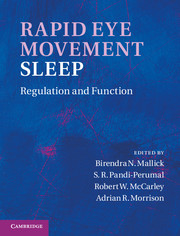Book contents
- Frontmatter
- Contents
- Contributors
- Preface
- Acknowledgments
- Organization
- Section I Historical context
- Section II General biology
- Section III Neuronal regulation
- 10 Understanding REM sleep: clues from brain lesion studies
- 11 Preoptic and basal forebrain modulation of REM sleep
- 12 Amygdalar regulation of REM sleep
- 13 Pontomedullary mediated REM-sleep atonia
- 14 Phenomenology and function of myoclonic twitching in developing rats
- 15 Pontine-wave generator: a key player in REM sleep-dependent memory consolidation
- 16 Hippocampal theta rhythm of REM sleep
- 17 Respiration during REM sleep and its regulation
- 18 Modulation of REM sleep by non-REM sleep and waking areas in the brain
- Section IV Neuroanatomy and neurochemistry
- Section V Functional significance
- Section VI Disturbance in the REM sleep-generating mechanism
- Index
- Plate section
- References
15 - Pontine-wave generator: a key player in REM sleep-dependent memory consolidation
from Section III - Neuronal regulation
Published online by Cambridge University Press: 07 September 2011
- Frontmatter
- Contents
- Contributors
- Preface
- Acknowledgments
- Organization
- Section I Historical context
- Section II General biology
- Section III Neuronal regulation
- 10 Understanding REM sleep: clues from brain lesion studies
- 11 Preoptic and basal forebrain modulation of REM sleep
- 12 Amygdalar regulation of REM sleep
- 13 Pontomedullary mediated REM-sleep atonia
- 14 Phenomenology and function of myoclonic twitching in developing rats
- 15 Pontine-wave generator: a key player in REM sleep-dependent memory consolidation
- 16 Hippocampal theta rhythm of REM sleep
- 17 Respiration during REM sleep and its regulation
- 18 Modulation of REM sleep by non-REM sleep and waking areas in the brain
- Section IV Neuroanatomy and neurochemistry
- Section V Functional significance
- Section VI Disturbance in the REM sleep-generating mechanism
- Index
- Plate section
- References
Summary
Summary
The data outlined in this chapter provides evidence to support a concept that the activation of pontine-wave (P-wave) generating neurons plays a critical role in long-term memory formation. The P-wave, generated by the phasic activation of glutamatergic neurons in the pons, is one of the most prominent phasic events of REM sleep. These P-wave generating neurons project to the hippocampus, amygdala, entorhinal cortex and many other regions of the brain known to be involved in cognitive processing. These P-wave generating glutamatergic neurons remain silent during wakefulness and slow-wave sleep (SWS), but during the transition from SWS to REM sleep and throughout REM sleep these neurons discharge high-frequency spike bursts in the background of tonically increased firing rates. Activation of these P-wave generating neurons increases glutamate release and activates postsynaptic N-methyl-D-aspartic acid (NMDA) receptors in the dorsal hippocampus. Activation of P-wave generating neurons increases phosphorylation of transcription factor cAMP response element binding protein (CREB) in the dorsal hippocampus and amygdala by activating intracellular protein kinase A (PKA). The P-wave generating neurons activation-dependent PKA-CREB phosphorylation increases the expression of activity-regulated cytoskeletal-associated protein (Arc), brain-derived neurotrophic factor (BDNF), and early growth response-1 (Egr-1) genes in the dorsal hippocampus and amygdala. The P-wave generator activation-induced increased activation of PKA and expression of pCREB, Arc, BDNF, and Egr-1 in the dorsal hippocampus is shown to be necessary for REM sleep-dependent memory processing. Continued research on P-wave generation and its functions may provide new advances in understanding memory and treating its disorders.
- Type
- Chapter
- Information
- Rapid Eye Movement SleepRegulation and Function, pp. 140 - 150Publisher: Cambridge University PressPrint publication year: 2011
References
- 2
- Cited by



